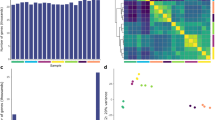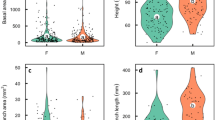Abstract
Unlike the taxa in some genera which show a range of variability in floral morphology, species of Solanum deviate very little from the typical hermaphroditic flower. The known deviant taxa fall into two classes: most are andromonoecious (male and hermaphroditic flowers on the same plant), and the remaining few are androdioedous (male flowers on one plant, hermaphroditic flowers on another)1.I report here evidence for the first instance of a truly dioecious species of Solanum, a significant discovery in the light of the floral uniformity of this large (second only to Senecio) and economically important genus. The most closely related species and species groups comprise only hermaphroditic forms; this dioecious species is among the few non-hermaphroditic forms native to the New World, the area of greatest species diversity of the genus. Furthermore, as shown below, the species is characterised by a functionally, though not morphologically, dioecious condition. Finally, this demonstration that the two floral forms represent different sexes of the same species, rather than (as originally described) different species, impels closer analysis of other species pairs.
This is a preview of subscription content, access via your institution
Access options
Subscribe to this journal
Receive 51 print issues and online access
$199.00 per year
only $3.90 per issue
Buy this article
- Purchase on Springer Link
- Instant access to full article PDF
Prices may be subject to local taxes which are calculated during checkout
Similar content being viewed by others
References
Symon, D. E. in The Biology and Taxonomy of the Solanaceae (eds Hawkes, J. G., Lester, R. N. & Skelding, A. D.) (Academic, London, 1979).
Correll, D. S. The Potato and Its Wild Relatives (Texas Research Foundation, Renner, 1962).
Bawa, K. S. & Opler, P. A. Evolution 29, 167–179 (1975).
Opler, P. A. & Bawa, K. S. Evolution 32, 812–821 (1978).
Lloyd, D. G. & Webb, C. J. Bot. Rev. 43, 177–216 (1977).
Martin, F. W. Evolution 21, 493–499 (1967).
Pandey, K. K. Evolution 14, 98–115 (1960).
Lloyd, D. G. Contrib. Gray Herb. Harv. Univ. 195, 3–133 (1965).
Anderson, G. J. & Gensel, P. G. Pollen Spores 18, 533–552 (1976).
Erdtman, G. Pollen Morphology and Plant Taxonomy: An Introduction to Palynology 1 (Hafner, New York, 1966).
Vuilleumier, B. S. Evolution 21, 210–226 (1967).
Westergaard, M. Adv. Genet. 9, 217–281 (1958).
Anderson, G. J. Brittonia 27, 209–222 (1975); 29, 116–128 (1977).
Arroyo, M. T. K. & Raven, P. H. Evolution 29, 500–511 (1975).
Charlesworth, B. & Charlesworth, D. Am. Nat. 112, 975–997 (1978).
Crowe, L. K. Heredity 19, 435–457 (1964).
Author information
Authors and Affiliations
Rights and permissions
About this article
Cite this article
Anderson, G. Dioecious Solanum species of hermaphroditic origin is an example of a broad convergence. Nature 282, 836–838 (1979). https://doi.org/10.1038/282836a0
Received:
Accepted:
Issue Date:
DOI: https://doi.org/10.1038/282836a0
This article is cited by
-
Pollen and stamen mimicry: the alpine flora as a case study
Arthropod-Plant Interactions (2017)
-
Reproductive biology of Solanum vespertilio (Solanaceae), a zygomorphic, heterantherous, enantiostylous, and andromonoecious rare Canary Islands endemic
Plant Systematics and Evolution (2015)
-
Sexual dimorphism in pollen grain size in cryptically dioecious Thalictrum macrostylum
Plant Systematics and Evolution (2009)
-
Cryptic dioecy is widespread in South American species of Symplocos section Barberina (Symplocaceae)
Plant Systematics and Evolution (2009)
-
Pollen morphology and functional dioecy inSolanum (Solanaceae)
Plant Systematics and Evolution (1998)
Comments
By submitting a comment you agree to abide by our Terms and Community Guidelines. If you find something abusive or that does not comply with our terms or guidelines please flag it as inappropriate.



